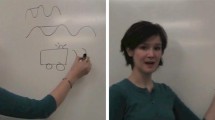Abstract
Authoring a multimedia document requires to specify both its spatial layout and its temporal organization, i.e. when and where objects such as pictures, texts and videos appear/disappear on /from the screen and when objects such as audios and videos start/end to play. In this paper, we present some benefits authors can gain when using an authoring tool in which constraints are used to specify these two kinds of information. We describe our experience in building Madeus, a constraint-based environment to design multimedia documents and we point out technical problems that still need to be solved to more completely satisfy author requirements.
Similar content being viewed by others
References
J. F. Allen (1983). “Maintaining Knowledge about Temporal Intervals” CACM, 26: 832–843.
E. Andre and T. Rist (1996). “Coping with Temporal Constraint in Multimedia Presentation Planning” 12th Europ. Conf. on Artificial Intelligence. W. Wahlster, editor, John Wiley & Sons Ltd.
R. Beacker, A. Rosenthal, N. Friedlander, E. Smith, and A. Cohen (1996). “A Multimedia System for Authoring Motion Pictures” Proc. of ACM Multimedia 96 Conference, Boston, pages 31–42.
A. Bellicha (1993). “Maintenance of Solution in a Dynamic Constraint Satisfaction Problem” 8th Proc. of Applications of Artificial Intelligence in Engineering, Toulouse, France, pages 261–274.
A. Borning, R. Lin, and K. Marriott (1997). “Constraints for the Web” Proc. of ACM Multimedia 97 Conference, Seattle, pages 173–181.
M. C. Buchanan and P. T. Zellweger (1993). “Automatic Temporal Layout Mechanisms” Proc. of ACM Multimedia 93 Conference, Anaheim, pages 341–350.
A. Cesta and A. Oddi (1996). “Gaining Efficiency and Flexibility in the Simple Temporal Problem” Proc. of Time'96 Workshop, Florida.
R. Dechter, I. Meiri, and J. Pearl (1991). “Temporal Constraint Networks” Artificial Intelligence, 49: 61–95.
H. Fargier, M. Jourdan, N. Layaida, and T. Vidal (1998). “Using Temporal Constraints Networks to Manage Temporal Scenario of Multimedia Documents” ECAI-Workshop on Spatial and Temporal Reasonning, Brighton UK.
A. Hafid, G. Bochman, and R. Dssouli (1998). “Distributed Multimedia Application and Quality of Service: A Review” Electronic Journal on Networks and Distributed Processing, 6(2).
L. Hardman, D. C. A. Bulterman, and G. Van Rossum (1994). “The Amsterdam Hypermedia Model: Adding Time and Context to the Dexter Model” CACM, 37(2): 50–62.
W. Hower and W. Graf (1996). “A Bibliographical Survey of Constraint-Based Approaches to CAD, Graphics, Layout, Visualization and Related Topics” Knowledge-Based Systems, Elsevier, 9(7): 449–464.
M. Jourdan, N. Layaida, L. Sabry-Ismail (1997). “Time Representation and Management in MADEUS: An Authoring Environment for Multimedia Documents” In M. Freeman, P. Jardetzki, and H. M. Vin, editors, Multimedia Computing and Networking 1997, SPIE 3020, San-Jose.
M. Jourdan, N. Layaida, L. Sabry-Ismail, C. Roisin, and L. Tardif (1998). “Madeus, an Authoring Environment for Interactive Multimedia Documents” ACM Multimedia'98, ACM, Bristol, UK, pages 267–272.
M. Y. Kim, J. Song (1995). “Multimedia Documents with Elastic Time” Proc. of the ACM 95 Multimedia Conference, San Francisco, pages 143–154.
N. Layaïda, L. Sabry-Ismail (1996). “Maintaining Temporal Consistency of Multimedia Documents Using Constraint Networks” In M. Freeman, P. Jardetzky, and H. M. Vin, editors, Multimedia Computing and Networking 1996, SPIE 2667, San-Jose, pages 124–135.
G. M. Oster (1995). “An Incremental Constraint-Based Object Layout Algorithm and Its Implementation” M. Sc. Thesis, University of Saskastchewan, Saskatoon, Canada.
Macromedia (1998). Director 6, on line:http://www.macromedia.com/.
K. Marriott (1995). “Unsolved Problems of Constraint-Based Computer Graphics” Proc. of the International Worshop on Constraints for Graphics and Visualization, Cassis, France.
F. Pachet and O. Delerue (1998). “MidiSpace: A Temporal Constraint-Based Music Spatializer” Proceedings of the Sixth ACM Conference on Multimedia, ACM Press, Bristol, pages 351–359.
R. Price (1993). “MHEG: An Introduction to the Future International Standard for Hypermedia Object Interchange” Proceedings of the First ACM Conference on Multimedia, ACM Press, Anaheim, pages 121–128.
M. Sannella, J. Maloney, B. Freeman-Benson, and A. Borning (1993). “Multi-Way Versus One Way Constraints in User Interfaces: Experiences with the Deltablue Algorithm” Software Practice and Experience, 23(5).
T. Schiex and G. Verfaillie (1993). “Two Approaches to the Solution Maintenance Problem in Dynamic Constraint Satisfaction Problems” Proc. of the IJCAI-93 / SOGMAN Workshop on Knowledge-Based Production Planning, Scheduling and Control, Chambery, France.
G. Trombettoni (1997). “Algorithmes de Maintien de Solution par Propagation Locale pour les Systémes de Contraintes” Doctorat Thesis, University of Nice, France.
G. Van Rossum, J. Jansen, K. Mullender, and D. Bulterman (1993). “CMIFed: A Presentation Environment for Portable Hypermedia Documents” Proceedings of the ACM 93 Multimedia Conference, California.
T. Vidal and H. Fargier (1997). “Contingent Durations in Temporal CSP: From Consistency to Controllabilities” 4th Int. Workshop on Temporal Representation and Reasoning (TIME97), Daytona Beach, Florida, May 10-11.
M. Vilain, H. A. Kautz, and P. Van Beek (1989). “Constraint Propagation Algorithms: A Revised Report” Readings in Qualitative Reasoning about Physical Systems. Morgan Kaufman.
M. Vazirgiannis, Y. Theodoris, and S. Sellis (1996). “Spatio-Temporal Composition in Multimedia Applications” Proc. of the IEEE ICSE'96 Conf. on Multimedia Software Development, Berlin, Germany.
L. Weitzman and K. Wittemburg (1994). “Automatic Presentation of Multimedia Documents Using Relational Grammars” Proc. of the second International Conference on Multimedia, ACM, San Francisco.
S. Wirag (1997). “Modeling of Adaptable Multimedia Documents” Proceedings of European Workshop on Interactive Distributed Multimedia Systems and Telecommunication Services (IDMS'97), Darmstadt.
CSS (1998). W3C Recommandation of Cascading Style Sheets Level 2 (CSS) 2.0. http://www.w3.org/TR/REC-CSS2.
SMIL (1998). W3C Recommandation of Synchronized Multimedia Integration Language (SMIL) 1.0. http://www.w3.org/TR/REC-smil.
Author information
Authors and Affiliations
Rights and permissions
About this article
Cite this article
Jourdan, M., Roisin, C. & Tardif, L. Constraint Techniques for Authoring Multimedia Documents. Constraints 6, 115–132 (2001). https://doi.org/10.1023/A:1009805527198
Issue Date:
DOI: https://doi.org/10.1023/A:1009805527198




